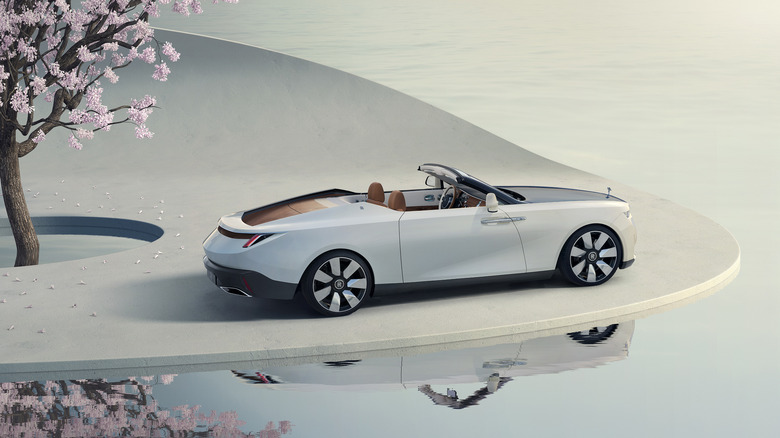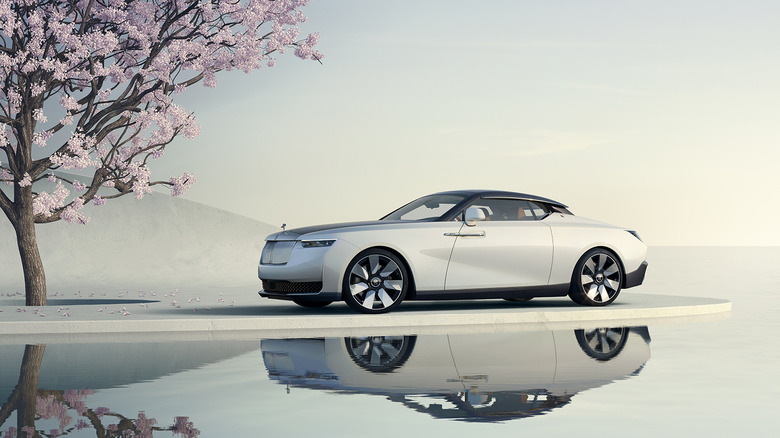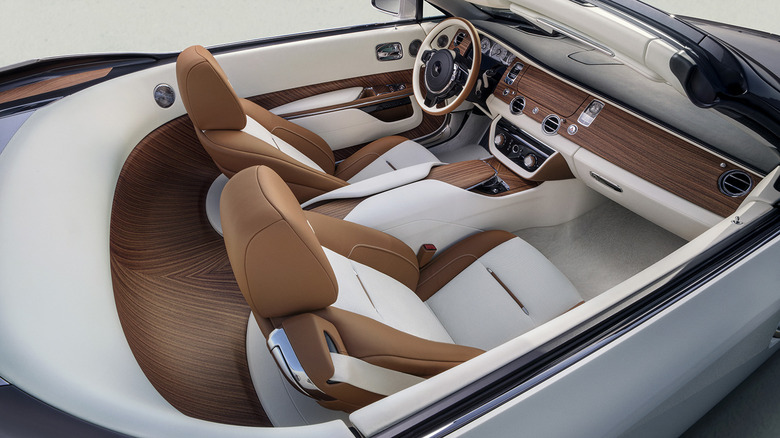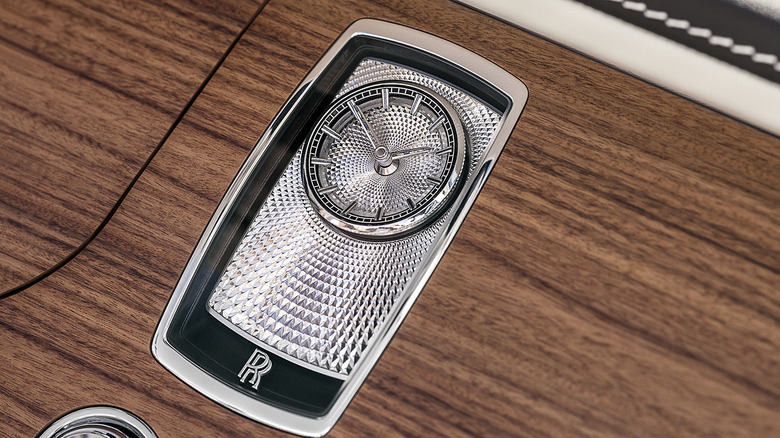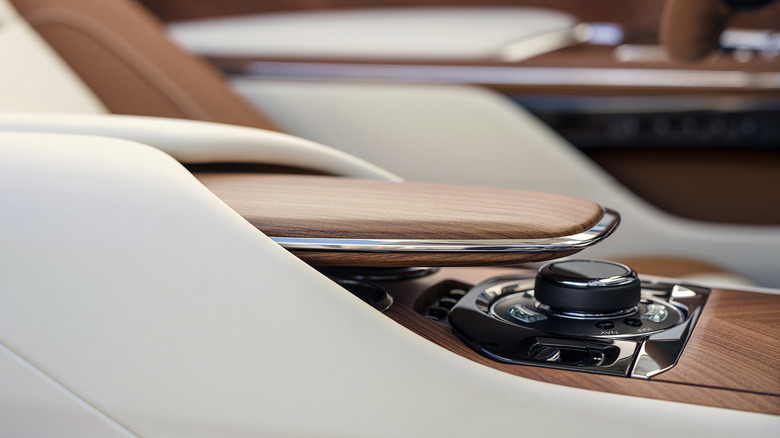The 4 Most Ridiculously Lavish Features Of The New Rolls-Royce Arcadia Droptail
Rolls-Royce has epitomized luxury and innovation since land speed record holder Charles Rolls and engineer Sir Henry Royce teamed up in 1904. Many classic Rolls-Royce cars have sold at auction for more than $1 million, and the brand has long been a favorite of Hollywood stars, musicians, and professional athletes. After more than a century of producing dinosaur-juice-powered marvels like the $350,000-plus Cullinan SUV, Rolls-Royce poked its front bumper into the electric vehicle space when it introduced the even pricier Spectre EV last summer.
Rolls-Royce has accepted commissions to build exactly four bespoke Droptail roadsters for its wealthiest customers, including the Arcadia shown above, which is the third of the four planned Droptails. The first, "La Rose Noir," (The Black Rose) sold for $20 million. Next came the equally remarkable Amethyst, which was built for a collector of precious gemstones and features a cluster of round Amethyst stones surrounding the brand's Spirit of Ecstasy hood ornament. The latest Droptail, the Arcadia, was named by its buyer after the location in Greek mythology known as "heaven on earth."
You might expect a vehicle that bears this name to have extraordinarily lavish features and ostentatious appointments, but Rolls-Royce worked with the unnamed Singaporean buyer to create a car that matched their understated manner perfectly. In a press release, head of design Alex Innis said, "The significance of Rolls-Royce Arcadia Droptail lies in its subtlety." Despite that claim, a close examination of the Arcadia Droptail reveals that the Arcadia Droptail sits at the extreme high end of luxury and craftsmanship, just like its two existing siblings.
The paint is an artistic and technological wonder
The Arcadia Droptail's paint may look like a garden-variety shade of white from a distance, but — like nearly every design element and feature of the car — it was chosen carefully by its buyer and developed especially for this one-off unit. The paint contains particles of glass and aluminum that give it depth and a shimmer under natural light. The lower carbon-fiber body panels were painted a solid silver to give a visual "lifting" effect.
The previous two Droptail models were also shrouded in paint customized for their owners. La Rose Noire was painted in a color Rolls-Royce calls "True Love." It took 150 applications, including five different shades of red lacquer, to render the hue that turns a dark purple in low light conditions. The Amethyst Droptail has a muted hue of its eponymous gemstone on its exterior that takes on elements of brown or grey tint under different ambient light conditions.
Interior of wood and white
The interior of the Arcadia Droptail is finished in wood and leather, including the striking two-tone white and tan seats. The two colors of leather used were named by the Arcadia Droptail's buyer and will only be used on this one car. The steering wheel is similarly designed, and the door panels, center console, and dashboard are clad in white leather and curved wood panels. Rolls-Royce used layers of carbon fiber applied in the same way Formula One cars are built to make a base for the wood panels that would withstand the vibrations from the Droptail's V12 engine. More than 8,000 hours were spent shaping and mounting the Arcadia Droptail's wood sections.
The V12 and curved wood panel at the rear of the car are the common threads tying the three existing Droptail models together; the aft panel is the largest single piece of wood Rolls-Royce has ever used in any of its cars. The rear section features also the same swooping buttresses on either side of the wood panel that are on La Rose Noir and the Amethyst Droptail.
Stunning timepiece
Another feature the Acadia Droptail shares with its bespoke cousins is the spectacular timepiece created specially for its owner. The press release calls the Acadia's in-dash clock "the most complex Rolls-Royce clock face ever created" and states it took two years to develop and five months to build.The clock's 119 facets are a tribute to the year 2023, when the buyer got their first sneak peek at this remarkable car. This was exactly 119 years after Rolls and Royce joined forces. The hour and minute hands are polished and glide over 12 markers, or chaplets, that are just 0.1 mm thick. Each chaplet was given a bridged infill design for readability at any angle; they were then hand-painted under a camera with 100x magnification capabilities. The chaplets and double R insignia that sits at the bottom edge of the clock were all machined from billet stainless steel and hand-polished before they were mounted.
VR-assisted development process
Perhaps the most outlandishly extravagant element of the Acadia Droptail isn't a tangible design feature like a rocket-ship V12 engine or clock that took five months to craft by hand. The buyer's native Singapore is a right-hand drive country, where cars travel on the left side of the road so the driver sits on the right. They wanted to be able to drive the car in a variety of international locations, though, so they specified that the car be built with left-hand drive. This chart from World Standards will show you which nations drive on which side of the road.
While there are exceptions, most European nations and most of the Western Hemisphere drive on the right side of the road, while the left side is used mainly in Great Britain and its former colonies. Singapore declared independence from the British crown in 1963 and rejected its colonizer's rare road-going custom. To simulate driving in different locations, Rolls-Royce engineers constructed a virtual reality 'holodeck' around the car as they built it and equipped the buyer with a VR headset so they could test-drive it virtually anywhere in the world.
